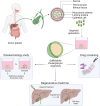Gallbladder cholangiocyte organoids
- PMID: 39945546
- PMCID: PMC11823593
- DOI: 10.1111/boc.202400132
Gallbladder cholangiocyte organoids
Abstract
Organoids are miniature three-dimensional (3D) organ-like structures developed from primary cells that closely mimic the key histological, functional, and molecular characteristics of their parent organs. These structures self-organize through cell-cell and cell-matrix interaction in culture. In the last decade, organoids and allied 3D culture technologies have catalyzed studies involving developmental biology, disease biology, high-throughput drug screening, personalized medicine, biomarker discovery, tissue engineering, and regenerative medicine. Many organoid systems have been generated from the gastrointestinal system, for example, intestine, stomach, liver, pancreas, or colon. Gallbladder cancer (GBC) is the most common and highly aggressive form of biliary tract cancer. GBC is rare in the west but has a high incidence in South America and India. Prolonged chronic inflammation is implicated in the pathogenesis of GBC but the driving molecular pathways leading to neoplasia are not well understood. Gallbladder cholangiocyte organoids (GCO) will facilitate the understanding of the evolution of the disease and novel therapeutic strategies. In this review, we have discussed alternative methodologies and culture conditions developed to generate GCO models, applications that these models have been subjected to and the current limitations for the use of GCOs in addressing the challenges in GBC research.
Keywords: Wnt pathway; anti‐cancer drug screen; biliary tract cancer; gallbladder cancer; organoids.
© 2025 The Author(s). Biology of the Cell published by John Wiley & Sons Ltd on behalf of Société Française des Microscopies and Société Biologie Cellulaire de France.
Conflict of interest statement
Vaskar Saha acknowledges receiving a research grant for a joint research project (unrelated to this study) from Gennova Biopharmaceuticals Ltd. The funding sources have no role in the design, practice or analysis of this study. Other authors have no conflicts of interest to disclose.
Figures



References
-
- Brandenberg, N. , Hoehnel, S. , Kuttler, F. , et al. (2020) High‐throughput automated organoid culture via stem‐cell aggregation in microcavity arrays. Nature Biomedical Engineering, 4, 863–874. - PubMed
-
- Clevers, H. (2016) Modeling development and disease with organoids. Cell, 165, 1586–1597. - PubMed
Publication types
MeSH terms
Grants and funding
LinkOut - more resources
Full Text Sources

